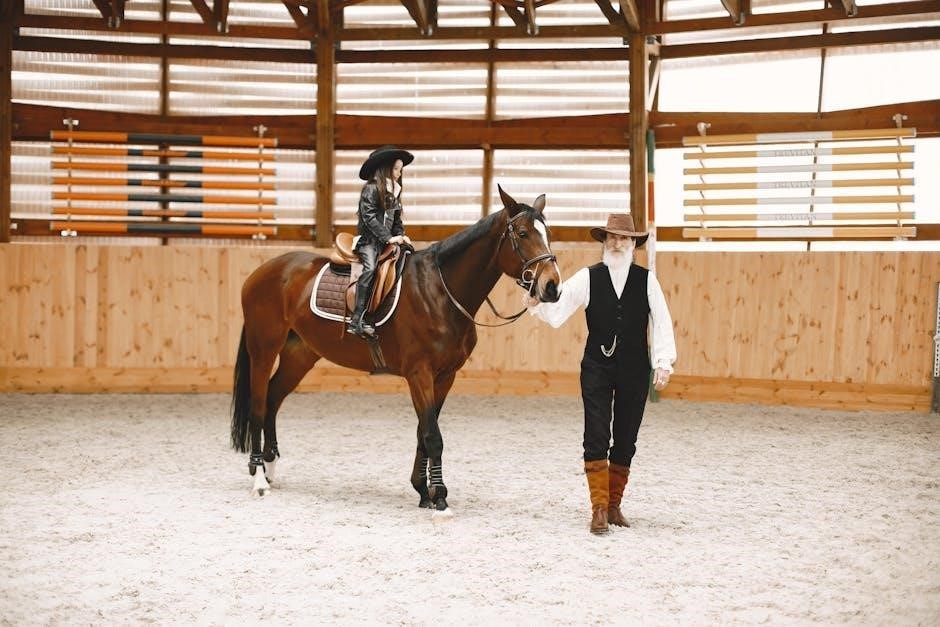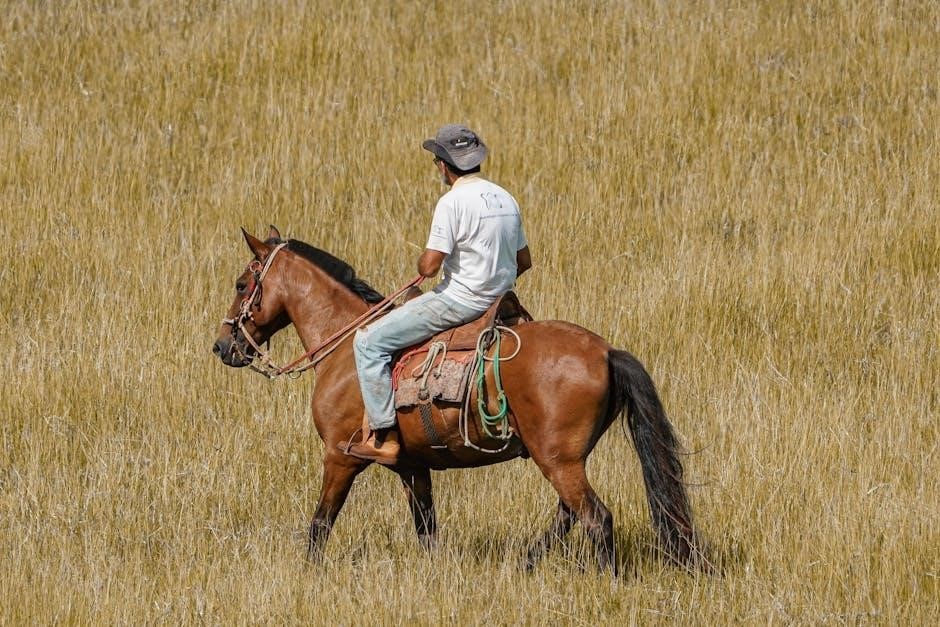Proper saddle fit is essential for both horse and rider comfort. This guide provides clear instructions on measuring and selecting the right English saddle, ensuring optimal fit and performance for various disciplines.
Why Proper Saddle Fit Matters
Proper saddle fit is crucial for both the horse’s comfort and the rider’s performance. A poorly fitting saddle can cause discomfort, muscle strain, and long-term damage to the horse, while also affecting the rider’s position and effectiveness. Ensuring the saddle fits correctly prevents pressure points, promotes even weight distribution, and maintains the horse’s natural movement. For the rider, a well-fitting saddle enhances balance, control, and communication with the horse. Neglecting proper fit can lead to behavioral issues in the horse and difficulty for the rider in maintaining a secure and effective position. A correct fit is essential for the well-being of both horse and rider.
How to Measure for an English Saddle
To ensure a proper fit, accurate measurements are essential. Start by measuring the seat size, typically from the pommel’s nail heads to the cantle’s midpoint, ranging from 12 to 19 inches. Next, assess the gullet size by measuring the space between the tree points, ensuring it accommodates the horse’s withers comfortably. Use a flexible ruler to trace the withers, determining the tree width needed. Consider the horse’s back length and shape to select a saddle that aligns with its structure. Proper measurement ensures both comfort and performance, preventing discomfort or damage. Always consult a size chart or expert advice for precise fitting.
Understanding Saddle Components
English saddles consist of key parts like the tree, panels, gullet, seat, flaps, and billets. These components work together to ensure proper fit, comfort, and performance for both horse and rider.
Seat Size and Measurement
Seat size is measured from the nail heads on the pommel to the center of the cantle. Sizes range from 12 to 19 inches in half-inch increments. Proper fit ensures rider comfort and balance. A well-fitted seat supports the rider’s pelvis, allowing optimal posture and control. Measuring accurately is crucial, as a seat too small or large can cause discomfort and affect performance. Use a flexible ruler or tape to ensure precise measurement, ensuring the saddle aligns with the rider’s anatomy for a secure and effective position.
Gullet Size and Its Importance
The gullet is the space between the pommel and cantle, crucial for ensuring the horse’s comfort and proper saddle fit. Its size must accommodate the horse’s withers without compressing them, allowing freedom of movement. The gullet’s width is determined by the saddle’s tree, which varies from narrow to extra-wide. A correctly fitted gullet ensures the saddle sits evenly, preventing discomfort or long-term damage to the horse’s spine and muscles. Improper gullet size can lead to restricted movement and discomfort.
Measuring the gullet accurately is vital for optimal fit and performance. Always consider the horse’s specific needs when determining gullet size.

Types of English Saddles
English saddles vary by discipline, with dressage, jumping, and all-purpose designs. Each type features unique elements suited to specific riding styles, ensuring optimal performance and comfort for both horse and rider.
Dressage, Jumping, and All-Purpose Saddles
Dressage saddles are designed for precision, featuring straight flaps and a deep seat to support the rider’s posture. Jumping saddles prioritize mobility, with lighter weights and shorter flaps for freedom of movement. All-purpose saddles offer versatility, blending elements of both disciplines for riders who participate in multiple activities. Each type is tailored to specific riding styles, ensuring optimal performance and comfort. The choice of saddle depends on the rider’s discipline, horse breed, and personal preference, making it crucial to select the right style for desired outcomes. This guide helps navigate these options to find the perfect fit for every rider and horse combination.
Fitting the Saddle to the Horse
Proper saddle fit ensures horse comfort and performance. Techniques like wither tracing and tree width assessment are crucial. The saddle must provide adequate clearance and even weight distribution for optimal comfort and long-term health.
Wither Tracing and Tree Width
Wither tracing is a fundamental step in determining the correct tree width for your horse. This process involves creating a template of the horse’s wither area to assess its shape and size. A properly fitted tree ensures the saddle sits evenly, avoiding pressure points. The tree width must match the horse’s wither profile to provide optimal comfort and prevent long-term damage. Using a flexible ruler or tracing tool, you can outline the wither contour and compare it to the saddle’s tree. This method ensures a precise fit, promoting the horse’s mobility and overall well-being.
Regular reassessment is crucial, as horses’ shapes can change over time due to age, muscle development, or weight fluctuations. Incorrect tree width can lead to discomfort, poor performance, or even injury. Always consult a professional fitter if unsure, as they can provide expert guidance tailored to your horse’s specific needs. Proper fit is not just about comfort—it’s essential for the horse’s health and your partnership.
Ensuring Proper Clearance and Comfort
Proper clearance and comfort are vital for your horse’s well-being. The saddle must not press on the withers or spine, allowing adequate space for movement and muscle development. Check for even weight distribution and ensure the saddle panels are in full contact with the horse’s back. A well-fitted saddle promotes proper posture and reduces the risk of discomfort or injury. Regularly inspect the fit as your horse’s shape may change over time. Proper clearance ensures your horse can move freely, while comfort supports their overall health and performance under saddle.

Fitting the Saddle to the Rider
Fitting the saddle to the rider ensures comfort and effectiveness. The seat size and flap length must support the rider’s position, balancing posture and control for optimal communication with the horse.
Seat Size and Rider Comfort
Seat size is crucial for rider comfort and control. A correctly fitted seat ensures the rider’s weight is evenly distributed, preventing pressure points. A seat that is too small can restrict movement, while one too large may cause instability. Proper fit allows the rider’s hips, shoulders, and heels to align, promoting balance and effective communication with the horse. Seat sizes typically range from 12 to 19 inches, measured from the front of the pommel to the middle of the cantle. Ensuring the right size enhances riding experience and overall performance for both rider and horse.
Flap Length and Rider Position
Flap length is tailored to the rider’s leg length and discipline, ensuring proper support and control. Longer flaps, common in dressage saddles, provide additional leg support, while shorter flaps, seen in jumping saddles, allow greater freedom. Correct flap length aligns the rider’s leg for optimal balance and communication with the horse. A flap too long may restrict movement, while one too short can compromise support. Proper flap length ensures the rider’s leg is positioned correctly, enhancing both comfort and effectiveness in the saddle, regardless of riding style or discipline.

Trying the Saddle on the Horse
Place the saddle on the horse’s back, centering it evenly. Ensure proper weight distribution and clearance for comfort and to prevent long-term damage to the horse.
Visual Checks for Proper Fit
Start by placing the saddle on the horse’s back, ensuring it sits evenly and centered. Check for adequate clearance over the withers, typically 2-3 fingers’ width. The panels should rest evenly on the horse’s back without bridging or excessive pressure points. Inspect the gullet plate to ensure it aligns with the horse’s spine and does not restrict movement. The cantle should be level with the pommel, and the saddle should not shift excessively when the horse moves. Proper fit ensures comfort, prevents long-term damage, and supports optimal performance for both horse and rider.
Test Riding and Adjustments
After placing the saddle on the horse, conduct a test ride to assess comfort and performance. Ensure the saddle remains balanced and stable during movement. The rider should feel secure, with knees resting naturally in the flap and weight evenly distributed. Check for any signs of discomfort or restriction in the horse’s movement. If the saddle shifts or causes pressure points, adjustments may be needed. Fine-tune the fit by altering the girth or pad, or consult a professional fitter for precise modifications. A proper fit ensures both horse and rider can perform at their best, making adjustments crucial for long-term comfort and effectiveness.

Seeking Expert Advice
Consulting a professional saddle fitter or equine expert is crucial for ensuring the perfect fit. They possess the knowledge and tools to accurately assess both the horse and rider, guaranteeing optimal comfort and performance. Experts use techniques like wither tracing and gullet measurement to determine the ideal saddle specifications. Regular check-ups with a fitter can address changes in the horse’s shape due to age, training, or health conditions. Their guidance is invaluable for maintaining long-term comfort and preventing issues. Don’t hesitate to seek expert advice for a tailored solution that benefits both you and your horse, ensuring a harmonious riding experience.
